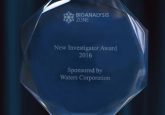New Investigator Award Finalist: Swarnapali De Silva Indrasekara

 Find out more about the other finalists
Find out more about the other finalists
Comments from voters:
- “Her personal life experiences are driving her intellectual passion for biosciences and that source of motivation is impressive. Moreover, she has clearly demonstrated her ability to impact the biosciences community with strong a strong publication resume.”
- “Her work has far reaching implications and it is focused at improving people’s lives.”
- “Pali is one of the most creative, thorough, and hard working scientist I have ever met. Her hard work has impacted myself and many other scientists in her field. Her desire to pursue translational research is very important as many great technologies are left on the benchside. She has all the qualities to make her goals a reality.”
Follow Bioanalysis Zone on twitter, facebook or LinkedIn to be the first to find out the winner!
What made you chose a career in bioanalysis?
When I was in college, I developed the desire to pursue an advanced degree with a research focus, but the exact research area was not certain to me. I, however, always wanted a career that would have a direct impact in the global health, especially in developing countries as I have seen the consequences of inadequate health facilities and inaccessibility to affordable disease screening on the quality of life. Then, my academic focus in Chemistry and Molecular biology brought the answer, exposing me to interdisciplinary research programs that align very well with my interests. That’s when I decided to invest my research career in translation research, which later narrowed down to the bioanalytical/medical field.
Describe the main highlights of your bioanalytical work?
I implement my expertise in nanochemistry and spectroscopy as analytical tools to innovate new technologies to understand processes significant in molecular biology and medicine. Surface enhanced Raman spectroscopy (SERS) is the main analytical tool of my interest, which is non-invasive and can be utilized even for single molecule detection under optimized conditions. My research niche lies at the interface of fundamental science and materials engineering to realize improved analytical measures for SERS-based bioanalytical and biomedical applications.
• I developed a US-patent granted chip-technology for direct, light-mediated detection of bio/chemical molecules in femtomolar regime, and multiplexed detection in nanomolar regime.
• Detection of cancers at very early stages is important for effective therapies. I developed nanoprobes as SERS tags that can differentiate healthy cells from disease cells based on the cancer biomarker expression levels on cell membranes using SERS-signal as the feedback.
• I contributed to a study that uses super-resolution fluorescence microscopy as a qualitative and semi-quantitative analytical technique to gain a mechanistic understanding of therapeutic nanoparticles-biomolecules interactions in-situ and assess biosafety of nanomaterials. This study reveals the loss of structural integrity of a serum protein on a single nanoparticle, providing unique information that could not otherwise be obtained from other ensemble analytical techniques. This work highlights the strength of single particle analytical tools in in assessing biosafety.
How has your work impacted your laboratory, the bioanalytical field and beyond?
The impact of my work in the field of analytical research is two faceted. I formulated design rules for engineering optically-active nanomaterials that facilitate lower limit of detection by SERS-based methods and also introduced new methodologies for label-free sensing in complex matrices at high analytical sensitivities. Detection of trace levels of biomarkers in living systems is critical in early stage disease diagnosis. It is of high importance in resource-limited settings, which pose the need for affordable diagnostic platforms. My research presents a non-conventional approach to address this issue, where extraordinary optical properties of noble metal nanomaterials are exploited a) to understand the biomolecular interactions at the single molecule level and b) to amplify the limit of detection of SERS-based techniques. For instance, SERS-based sensing technologies I developed during my research career have been transferred and implemented in different disciplines, ranging from fundamental molecular biology studies to theranostics to catalysis to art conservation.
Describe the most difficult challenge you have encountered in your scientific career and how you overcame it?
Nanoparticle clusters are known to provide higher signal amplification for SERS-based nanosensors. My first graduate research project was to develop ordered gold nanoparticle clusters as SERS-tags to identify over-expressed membrane receptor proteins for early stage cancer diagnostics. Fabrication of ordered clusters in solution with a significant yield and homogeneity is, however challenging due to high degree of freedom in solution. Yet, such cluster formation is more useful due to its higher versatility. I developed an approach considering molecular-level interactions and bioconjugation chemistry, which resulted, clustered nanoparticles. Experimental modifications alone, however, created a limitation where no further increase in the yield of clusters was observed. At that point, I sought feedback from a colleague with computational physics expertise. Our discussion led to collaboration, we took kinetics and nanoscale interactions into consideration to model cluster formation in solution. Information from simulations was helpful to increase cluster yield that would not otherwise achievable. As-engineered nanoclusters demonstrated faster SERS-based detection of diseased cells compare to fluorescence–based imaging. This was also the moment in my research career that I learnt to initiate and establish collaborative research efforts, and explore the contribution of computational science for progression of applied science at first hand.
Describe your role in bioanalytical communities/groups?
I am involved in several interdisciplinary collaborative research efforts that integrate plasmonic nanomaterials-based analytical techniques in medical diagnostics and imaging. I invest my expertise in analytical performance-oriented materials development, and Raman-spectroscopy-based sensing technologies to unveil mechanistic understandings of the molecular biology of invasive cancers.
I am also involved in projects as a part of the global health imitative to device field-deployable diagnostic schemes for mosquito-borne infectious diseases. My role in this team as an analytical chemist is to fabricate the underlying chemistry of the biosensing assays to realize higher specificity and sensitivity for biomarkers in complex matrices such as blood.
I am also advising junior researchers from engineering background to facilitate their transition into applied science. In that regard, I guide them in controlling drug retention time/release profile in nanocapsules by proper engineering of surface chemistries.
In addition, I have also been participating in science outreach events to increase the awareness of the young generation on the impact of light-based technologies in global health. I have introduced several high school students to the optics-based sensing and diagnostics technologies, and also involved as a spokesperson for the Duke-light technology event for kids, sharing the multi-faceted nature of photonics based technologies in medicine.
List up to five of your publications in the field of bioanalysis:
1A. Swarnapali D. S. Indrasekara, Bryan Paladini, Dominik Naczynski, Prabhas Moghe, Laura Fabris “Dimeric Gold Nanoparticle Assemblies as Tags for SERS-based Cancer Detection”, Adv. Healthcare Mater. 2013, 2, 1370
2A. Swarnapali D. S. Indrasekara, Sarah Meyer, S. Shubeita, L. C. Feldman, T. Gustafsson, Laura Fabris “Gold Nanostar Substrates for SERS-based Chemical Sensing in the Femtomolar Regime”, Nanoscale, 2014, 6, 8891
3A. Swarnapali D. S. Indrasekara, Laura Fabris “The Evolution of SERS Tags Toward Genetic Profiling”,Bioanalysis, 2015, 7:2, 263
4Sergio Dominguez-Medina, Lydia Kisley, Lawrence J. Tauzin, Anneli Hoggard, Bo Shuang, A. Swarnapali D. S. Indrasekara, Lin-Yung Wang, Paul Derry, Eugene Zubarev, Christy F. Landes, Stephan Link, Adsorption and Unfolding of a Single Protein Triggers Nanoparticle Aggregation, ACS Nano, 2016, 10 (2), 2103–2112
5Ethan A. Perets, A. Swarnapali D. S. Indrasekara, Alexis Kurmis, Natalya Atlasevich, Laura Fabris, Julie Arslanoglu, Carboxy-terminated Immuno-SERS Tags Overcome Non-specific Aggregation for the Robust Detection and Localization of Organic Media in Artworks, Analyst, 2015, 140, 5971-5980




